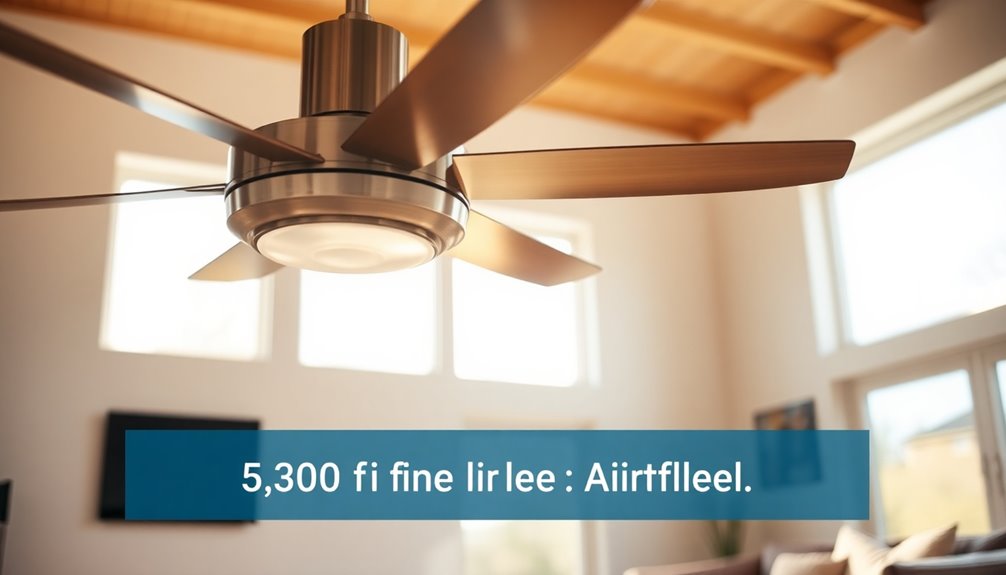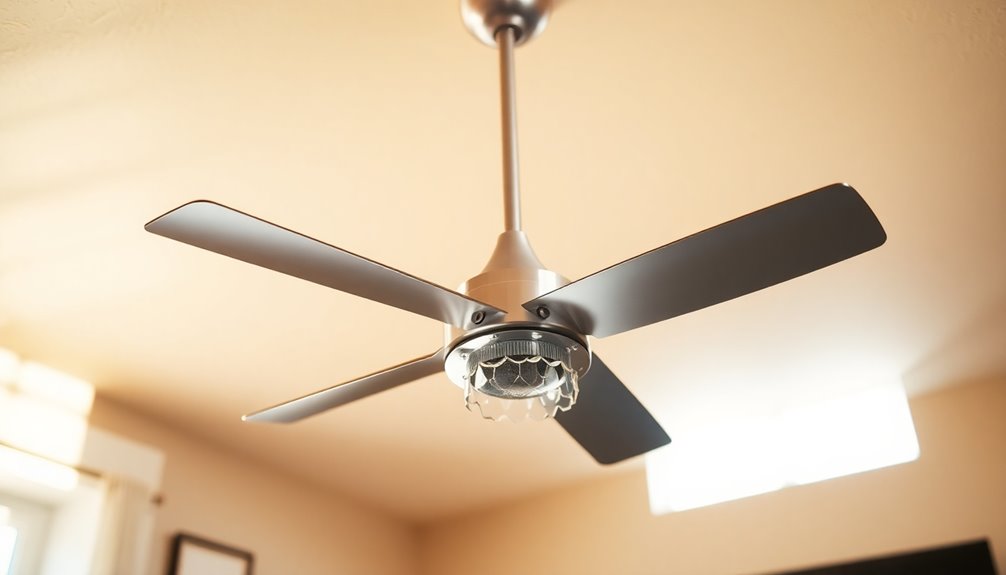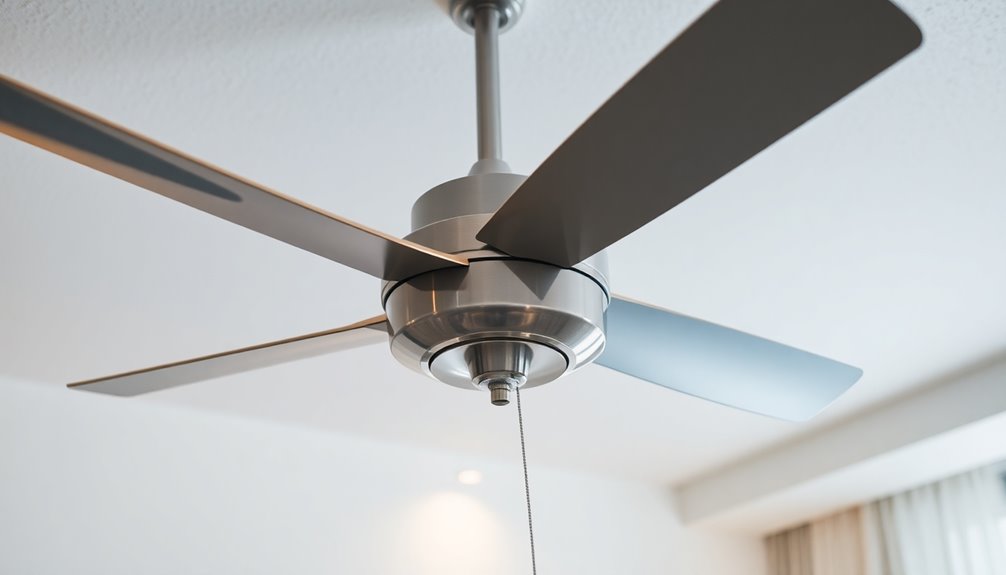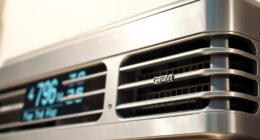A good airflow efficiency for a ceiling fan starts at 75 CFM (cubic feet per minute) per watt. However, for peak performance, aim for Energy Star certified fans, which require at least 155 CFM/watt on low speed and 100 CFM/watt on medium. In standard rooms, you should look for fans that deliver between 4,000 to 5,000 CFM for effective cooling. Choosing a fan with higher efficiency not only enhances comfort but can also cut your energy costs by up to 30%. There's more to discover about maximizing your fan's performance to create the perfect indoor climate.
Key Takeaways
- A good airflow efficiency for ceiling fans is at least 75 CFM/watt for decent performance.
- Energy Star certified fans require a minimum of 155 CFM/watt at low speed and 100 CFM/watt at medium.
- Ideal CFM ratings range from 4,000 to 5,000 for standard rooms with 8-ft ceilings.
- Higher blade pitch and lightweight materials significantly enhance airflow efficiency and overall CFM ratings.
- Regular maintenance and advanced control systems can optimize airflow efficiency and reduce energy consumption by up to 30% to 40%.
Understanding Airflow Efficiency

Understanding airflow efficiency is essential when choosing a ceiling fan for your home. You'll want to look at the CFM, or cubic feet per minute, which measures how much air the fan moves. A good airflow efficiency rating is calculated as CFM per watt, with an acceptable minimum of 75 CFM/watt for decent performance.
If you're seeking energy efficiency, consider Energy Star certified fans. They've strict standards, requiring at least 155 CFM/watt at low speed, 100 CFM/watt at medium speed, and 75 CFM/watt at high speed settings.
Choosing a fan with a higher CFM rating and lower wattage means better airflow efficiency, which not only cools your space more effectively but also cuts down on energy costs. In fact, fans that achieve high airflow efficiency can lower energy consumption by up to 30%.
What Is CFM?

CFM, or Cubic Feet per Minute, measures how much air a ceiling fan moves at its highest speed. This metric is essential because it directly impacts your comfort level in any space. A higher CFM indicates greater airflow, which generally leads to better cooling and overall comfort.
For residential ceiling fans, standard CFM ratings typically range from 1,500 to 7,000. However, if you're aiming for ideal comfort, look for fans in the perfect range of 4,000 to 5,000 CFM. Regular use of ceiling fans can also help improve indoor air quality, especially when combined with air purifiers. Additionally, the technology used in modern fans has evolved to enhance airflow efficiency, making them more effective at cooling.
When evaluating ceiling fan efficiency, remember that airflow efficiency is determined by dividing the CFM by its wattage. A minimum efficient CFM rating of 75 is generally considered acceptable, but higher ratings can greatly enhance your experience. Additionally, models with HEPA filtration can significantly improve indoor air quality, making a comfortable environment even healthier.
Various factors influence CFM, including blade design, motor power, and fan size, all of which contribute to the overall performance of a ceiling fan.
Understanding CFM helps you make informed decisions when selecting a ceiling fan, ensuring you find one that meets your airflow needs while maximizing ceiling fan efficiency.
Importance of High CFM

Why should you prioritize a high CFM rating when choosing a ceiling fan? A high CFM (Cubic Feet per Minute) rating means the fan can move a larger volume of air, enhancing cooling effectiveness and overall comfort in your room.
When you select a fan with a high CFM, you're not just opting for better airflow; you're also investing in energy efficiency. Ideally, a ceiling fan should have a minimum airflow efficiency of 75 CFM per watt, guaranteeing considerable air movement without consuming excessive power. Additionally, fans designed with cultural significance in mind often feature unique craftsmanship that can enhance your living space aesthetically. Furthermore, just like air purifiers improve indoor air quality, ceiling fans can help maintain a comfortable living environment by promoting air circulation. Regular maintenance, such as cleaning filters, can further enhance the efficiency of both ceiling fans and air purifiers. High CFM fans, similar to the VEVA ProHEPA 9000, can effectively target allergens and create a more pleasant atmosphere.
Fans boasting a CFM rating between 4,000 and 7,000 for residential use can greatly reduce your reliance on air conditioning, potentially lowering your energy costs by up to 30%. This is essential because a fan with high CFM and low energy usage maximizes comfort while minimizing your electricity bills.
Moreover, when you choose a ceiling fan that's Energy Star certified, you confirm that it meets energy-saving standards while delivering high-quality airflow performance. Just like with air purifiers, high airflow efficiency in ceiling fans contributes to improved overall well-being by enhancing indoor air circulation.
Factors Affecting Airflow Efficiency

When it comes to airflow efficiency, you need to evaluate several key factors.
Blade design, motor performance, and room size can all impact how effectively your ceiling fan circulates air.
Blade Design Impact
The impact of blade design on airflow efficiency is vital for maximizing the performance of ceiling fans. When you consider the blade pitch, or the angle at which the blades are set, you'll notice that steeper pitches typically lead to higher CFM (cubic feet per minute) ratings. This means better airflow efficiency, helping you stay cool in warmer months. Additionally, incorporating energy-efficient designs can further enhance the overall performance of ceiling fans.
Furthermore, the materials used in blade construction, like lightweight composites or wood, can greatly affect both durability and performance. Lightweight materials often enhance airflow efficiency, allowing for easier movement through the air. The use of advanced control systems can also optimize the operation of ceiling fans for improved energy savings.
Longer blades usually generate more airflow compared to shorter ones, making them ideal for larger rooms.
Moreover, the shape of the blades plays a vital role. Variations such as rounded tips or tapered edges can optimize airflow patterns, increasing comfort and cooling effectiveness in your space. Additionally, understanding the importance of maintenance practices can also contribute to the longevity and efficiency of ceiling fans, similar to how proper care impacts the performance of heat pumps.
Motor Performance Efficiency
Motor performance plays an essential role in determining how efficiently a ceiling fan operates. The type of motor used greatly impacts airflow efficiency, measured in Cubic Feet per Minute (CFM). Higher quality motors can deliver better CFM ratings while consuming less energy. For instance, DC motors are renowned for their increased power and efficiency, often providing higher CFMs compared to traditional AC motors at lower wattage.
To understand the factors affecting motor performance, consider the following table:
| Factor | Impact on Airflow Efficiency |
|---|---|
| Motor Type | DC motors offer better performance than AC motors |
| Materials Used | High-quality materials improve energy conversion |
| Motor Design | Optimized designs enhance rotational movement |
| Adjustable Speeds | Allows tailored airflow for varying needs |
| Regular Maintenance | guarantees sustained performance and efficiency |
Room Size Considerations
Choosing the right ceiling fan goes beyond just considering motor performance; room size greatly influences airflow efficiency.
To guarantee ideal ceiling fan airflow, you need to match the fan's CFM ratings with your room's dimensions. Here's a quick guide to help you:
- Up to 75 square feet: Aim for 1,500 to 3,000 CFM.
- 76 to 144 square feet: Look for 3,000 to 4,500 CFM.
- 145 to 225 square feet: Choose fans with 4,500 to 6,500 CFM.
- Over 225 square feet: Fans should exceed 6,500 CFM for effective cooling.
Keep in mind that the height of your ceiling also plays a significant role. Proper disposal habits can also extend the lifespan of your ceiling fan, ensuring it operates efficiently over time.
Ideally, fans should be mounted 7 to 9 feet above the floor to maximize airflow efficiency across various room sizes. Additionally, selecting fans with high CFM ratings can significantly enhance your cooling experience.
By considering both room size and appropriate CFM ratings, you can enhance your space's comfort and guarantee that your ceiling fan performs at its best.
Measuring Airflow Efficiency

When it comes to ceiling fans, measuring airflow efficiency is essential for guaranteeing you're getting the best performance without breaking the bank on energy costs.
To calculate airflow efficiency, you'll divide the CFM (Cubic Feet per Minute) by the wattage. This gives you a clear metric for how much airflow you're getting for each watt of energy consumed.
A good rule of thumb is to aim for a minimum airflow efficiency rating of 75 CFM/watt. This guarantees that your fan provides adequate air movement without excessive energy use.
However, if you're looking for something more efficient, consider Energy Star certified fans. These models have stricter standards, requiring an airflow efficiency of at least 155 CFM/watt on low speed and 100 CFM/watt on medium speed.
High airflow efficiency not only improves your comfort by enhancing air circulation but also helps lower your electricity costs by reducing the need for air conditioning.
If you choose a fan with integrated LED lighting, you'll further boost overall efficiency, as these lights consume less power while maximizing airflow performance.
Recommended CFM for Rooms

For ideal comfort in your home, selecting the right CFM rating for your ceiling fan is crucial. The airflow for a ceiling fan directly impacts your comfort level, so knowing the recommended CFM for different room sizes can make all the difference.
Consider the following guidelines when choosing a ceiling fan:
- Standard rooms with 8-foot ceilings: Aim for 4,000 to 5,000 CFM for good airflow.
- Smaller or lower-ceiling rooms: A fan with 1,500 to 3,000 CFM should suffice for adequate cooling.
- Larger spaces or rooms with high ceilings: Look for fans offering CFM ratings over 6,000 to guarantee effective air circulation.
- Energy Star certified fans: They require at least 1,250 CFM on low speed and 5,000 CFM on medium speed.
Energy Efficiency Standards

When choosing a ceiling fan, it's essential to take into account Energy Star requirements and airflow efficiency ratings.
These standards guarantee you get the best performance while keeping energy costs low.
Energy Star Requirements
Energy Star requirements set the standard for ceiling fans aiming to deliver both performance and energy efficiency. If you're considering a ceiling fan, look for Energy Star certification to guarantee you're getting the best in airflow efficiency and cost savings.
Here are some key criteria:
- Minimum CFM ratings: 1,250 for low speed, 5,000 for medium speed, and 7,500 for high speed
- Minimum airflow efficiency: 155 CFM per watt at low speed, 100 CFM per watt at medium speed, and 75 CFM per watt at high speed
- Potential energy savings: some models cut energy use by up to 40%
- Contribution to sustainability: lower energy consumption benefits the environment
Choosing Energy Star certified ceiling fans means you'll enjoy high efficiency without sacrificing performance.
These fans not only help you stay cool but also reduce your electricity bills. By complying with Energy Star requirements, manufacturers provide a win-win solution for consumers and the planet.
Airflow Efficiency Ratings
Choosing an Energy Star certified ceiling fan guarantees you get the best airflow efficiency ratings, which play a pivotal role in your fan's performance.
A good airflow efficiency rating is defined by specific CFM (Cubic Feet per Minute) standards based on the fan's speed setting. For high-speed operation, aim for a minimum of 75 CFM per watt. This guarantees that your fan circulates air effectively while keeping energy consumption low.
When using medium speed, a ceiling fan should achieve at least 100 CFM per watt. This strikes a balance between comfort and efficiency, allowing for effective air circulation without wasting electricity.
If you prefer low-speed settings, look for a fan that meets or exceeds 155 CFM per watt. This level of efficiency helps maintain a comfortable environment without excessive energy use.
Impact on Energy Costs
While selecting the right ceiling fan can enhance your comfort, it also plays a crucial role in managing energy costs. By focusing on airflow efficiency, you can enjoy a cooler space without breaking the bank.
Here's what to take into account:
- Aim for a minimum of 75 CFM/watt for effective energy use.
- Look for Energy Star certified fans with high CFM ratings: 155 CFM/watt at low speed, 100 CFM/watt at medium, and 75 CFM/watt at high speed.
- Choose fans that combine high CFM with low wattage to maximize savings.
- Regular maintenance, like cleaning and proper installation, boosts efficiency.
Selecting the Right Ceiling Fan

When it comes to selecting the right ceiling fan, understanding airflow efficiency is essential for guaranteeing comfort and energy savings. You'll want to take into account several factors to make the best choice for your space.
First, evaluate the room size. For standard-sized rooms, look for a fan that provides between 4,000 and 5,000 CFM. Additionally, check the fan size and its specifications to confirm it meets your airflow needs.
Here's a quick comparison of airflow efficiency ratings for different fan types:
| Fan Type | CFM per Watt |
|---|---|
| Energy Star Low Speed | 155 CFM |
| Energy Star Medium Speed | 100 CFM |
| Energy Star High Speed | 75 CFM |
| Standard Ceiling Fan | At least 75 CFM |
Choosing a fan with energy-efficient motors can also contribute to reducing electricity bills while maintaining comfort.
Benefits of Efficient Ceiling Fans

Here are some key benefits of using efficient ceiling fans:
- Cost savings: Reduce energy costs by up to 30% by relying less on air conditioning.
- Comfort enhancement: High CFM fans provide consistent airflow, creating a comfortable environment year-round.
- Energy Star certification: Choosing Energy Star certified fans guarantees excellent performance with minimum energy consumption.
- Longevity: Regular maintenance, like cleaning blades, can boost performance and extend the lifespan of your fan.
With a minimum airflow efficiency rating of 75 CFM per watt, efficient ceiling fans guarantee you get the best out of your investment.
In addition, consistent maintenance helps prevent costly repairs and replacements, similar to air purifier maintenance. Not only do they help circulate air effectively, but they also contribute to a sustainable living space. By selecting the right model and maintaining it properly, you'll enjoy both comfort and savings in your home.
Innovations in Fan Technology

Innovations in fan technology have revolutionized the way we experience cooling and airflow in our homes. With the introduction of energy-efficient DC motors, you can enjoy up to 70% less energy consumption compared to traditional AC motors, while still benefiting from high airflow efficiency.
These powerful motors provide impressive CFM ratings, ensuring you feel the breeze when you need it most.
Smart ceiling fans take convenience to the next level, allowing you to control speed, direction, and scheduling through mobile apps. This not only enhances your comfort but also helps you manage energy usage more effectively.
Advanced blade designs, featuring variable pitch and aerodynamically shaped edges, also contribute to improved airflow efficiency, moving more air with less energy consumption.
Some modern fans come with integrated sensors that automatically adjust their speed based on room occupancy and temperature, optimizing airflow in real-time.
Look for Energy Star certified fans, as they meet strict energy efficiency guidelines and utilize cutting-edge technologies to maximize CFM per watt, achieving up to 155 CFM/watt on low speed.
These innovations make it easier than ever to stay cool while keeping energy costs down.
Frequently Asked Questions
What Is Considered a Good CFM for a Ceiling Fan?
When choosing a ceiling fan, you should look for a CFM (Cubic Feet per Minute) rating between 4,000 and 7,000 for ideal airflow in standard rooms.
For effective circulation, aim for around 4,000 to 5,000 CFM, which provides comfort without excessive wind.
If you have larger spaces or higher ceilings, consider fans with higher CFM ratings to guarantee adequate airflow.
Is 6000 CFM Good for a Fan?
Yes, 6,000 CFM is excellent for a ceiling fan, especially if you're dealing with larger rooms or high ceilings.
This level of airflow can dramatically cool down your space, making it more comfortable.
However, in smaller areas, the wind sensation might feel a bit intense.
If you choose a fan with this rating, just guarantee it maintains a good wattage to keep your energy efficiency in check.
You'll likely enjoy the benefits!
What Is Airflow Efficiency?
Did you know that a fan with an airflow efficiency of 75 CFM per watt is considered the minimum for energy efficiency?
Airflow efficiency measures how effectively a fan circulates air compared to the energy it consumes. You calculate it by dividing the fan's airflow (in cubic feet per minute, or CFM) by its power usage (in watts).
Higher efficiency means better performance and lower energy bills, making it essential when choosing a ceiling fan.
Is 8000 CFM Good?
Is 8,000 CFM good? It really depends on where you plan to use it.
For larger spaces, like open-concept areas, that high airflow can be beneficial.
However, in smaller rooms, it might create discomfort due to excessive wind movement.
You've gotta consider the room size and ceiling height to avoid drafty conditions.
If you're aiming for comfort, balance is key—too much airflow can be just as problematic as too little.
Conclusion
In the end, choosing a ceiling fan with good airflow efficiency isn't just about comfort; it's a step towards a greener home. You'll find that fans with higher CFM ratings offer not only better air circulation but also lower energy bills. As technology improves, so do your options, aligning convenience and sustainability. So, when you flip that switch, you're not just cooling off—you're making a choice that benefits both you and the planet.









